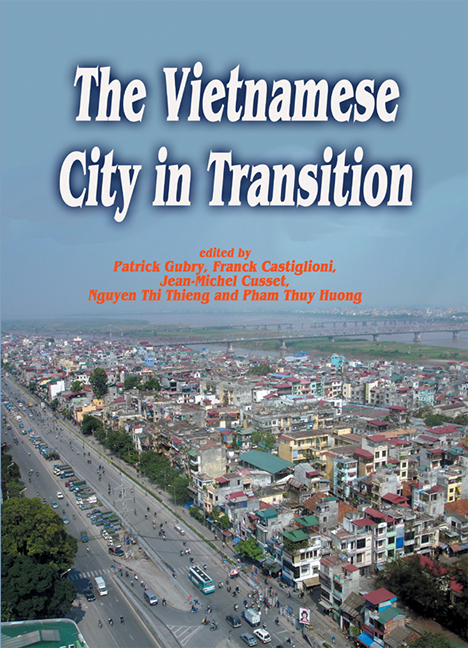Book contents
- Frontmatter
- Contents
- List of Tables
- List of Figures
- List of Colour Plates
- Foreword
- Acknowledgments
- List of Acronyms
- The Editors
- The Contributors
- Introduction: Urban Research in Action: Context, Aims, Directions
- 1 Urban Transition in Vietnam: Its Processes and Stakeholders
- 2 Road System and Urban Recomposition in Hanoi
- 3 Intra-Urban Mobility in Ho Chi Minh City and Hanoi
- 4 Resettlement Issues of Informal Settlement Areas in Ho Chi Minh City: From Large-scale Programmes to Micro-projects
- 5 Changes in Public Water Management: Transition, Compromise, and Innovation
- 6 The Role of Civil Society in Urban Environmental Management
- 7 Assessment of Projects Supported by Official Development Assistance Based on Partnership Formats: From Ho Chi Minh City to Hanoi
- 8 Relations between International Consultants and the Local Engineering Force in Urban Infrastructures
- 9 Conclusion: A Diverse Approach to Research on Urban Issues
- General Bibliography
- Index
- Plate Section
3 - Intra-Urban Mobility in Ho Chi Minh City and Hanoi
Published online by Cambridge University Press: 21 October 2015
- Frontmatter
- Contents
- List of Tables
- List of Figures
- List of Colour Plates
- Foreword
- Acknowledgments
- List of Acronyms
- The Editors
- The Contributors
- Introduction: Urban Research in Action: Context, Aims, Directions
- 1 Urban Transition in Vietnam: Its Processes and Stakeholders
- 2 Road System and Urban Recomposition in Hanoi
- 3 Intra-Urban Mobility in Ho Chi Minh City and Hanoi
- 4 Resettlement Issues of Informal Settlement Areas in Ho Chi Minh City: From Large-scale Programmes to Micro-projects
- 5 Changes in Public Water Management: Transition, Compromise, and Innovation
- 6 The Role of Civil Society in Urban Environmental Management
- 7 Assessment of Projects Supported by Official Development Assistance Based on Partnership Formats: From Ho Chi Minh City to Hanoi
- 8 Relations between International Consultants and the Local Engineering Force in Urban Infrastructures
- 9 Conclusion: A Diverse Approach to Research on Urban Issues
- General Bibliography
- Index
- Plate Section
Summary
Ho Chi Minh City and Hanoi are the two largest urban centres in Vietnam as far as population and economic potential are concerned. In recent years, population growth has been a major factor in the economic growth of these centres. However, in both Ho Chi Minh City and Hanoi, the hike in population is causing critical problems in the urban development process. As these cities grow, so does the movement of people in them.
Intra-urban Movement
There has been a tremendous increase in population movement in Vietnam since 1986, when an economic liberalization policy (Doi Moi or Renovation) began to be implemented. Although considerable research has already been done on the migration aspect, there is still not a clear understanding of mobility within the major centres, with a particular focus on the two largest ones, Ho Chi Minh City (overall population of 5 million with 3.7 million in the urban area in 1999) and Hanoi (overall population of 2.7 million with 1.5 million in the urban area). A positive migration balance from the city centres to the suburbs has been observed, based on the two most recent censuses, one conducted in 1989 and the other in 1999. There is a considerable increase in intra-urban mobility in the wake of fast-track urbanization, and this is becoming a key urban planning consideration. This evolution and the policies implemented are impacting the living space of citizens in terms of environment (suggesting improvement) and are tending to increase routine travel distances (suggesting deterioration).
Such intra-urban mobility (that taking place within the administrative limits of the two cities) includes on the one hand intra-urban migration or residential mobility (changing one's residence within the administrative limits), and on the other hand temporary mobility, including commuting movements. This is tending to accentuate the inadequacy of urban infrastructure and transit because of increasing the density of suburban zones, which are the least affluent.
- Type
- Chapter
- Information
- The Vietnamese City in Transition , pp. 63 - 100Publisher: ISEAS–Yusof Ishak InstitutePrint publication year: 2010

